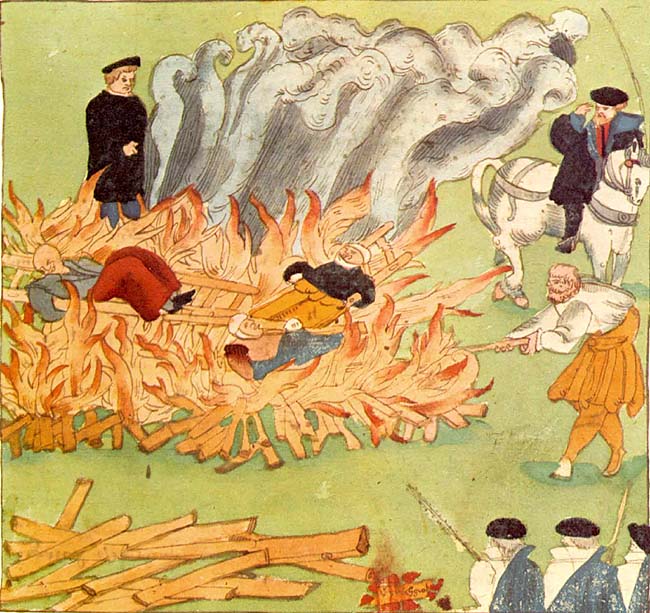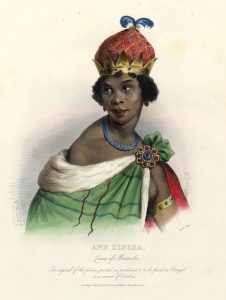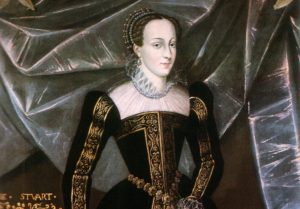In today’s world, when someone thinks of a witch, they normally picture one of a few things: the infamous Wicked Witch of the West that was out to get our beloved Dorothy; Bette Midler’s crazy looking character in Hocus Pocus; or a sparkly, purple and black ‘Party City’ outfit that young girls wear as a sort of ‘right of passage’ Halloween costume. Some may even think back to their high school history lessons about the Salem Witch Trials during the late 1600’s in colonial America. These images, however, are drastically different from those a 15th-century European would have pictured. They would have conjured up the image of a woman who wasn’t religious, who went against social norms, who had supernatural powers, and who therefore was most definitely associated with the devil.1 These Europeans would have pictured the faces of the many women accused and killed in the witch hunts of the time that were in large part driven by skewed societal perceptions, religious fears, and hysteria.
The witch hunts in Europe occurred on a much larger scale than those that took place in Salem Village. Records suggest that the hunts began as early as the 14th century and went on until around 1650, gaining the most momentum during the late 15th century. In total, the executions of supposed witches by Europeans numbered between 200,000 and 500,000, with 85% or more of those accused of and executed for witchcraft being women.2 Additionally, around 95% were specifically poor, old, single, or widowed women.3 Based on social perceptions of the time, these numbers, quite frankly, are not surprising. It is said that “heresy evidence, a major element during the dominance of the European witch craze, was that Satan recruited servants, mostly women, by signing a pact with them and turned them into his sexual subordinates.”4 It was understood by society members that these women who made such a pact with the devil were “female witches [given] the opportunity to commit evil deeds,” and that as a result of their pact and evil-doings, “[their] souls…belonged to the devil, and these women would serve in hell upon their death.”5 Society members also understood that single, elderly, poor, and/or widowed women were outcasts, and in some cases were even thought to be living sinful lives. The perception of all women as impressionable, and the perception of certain types of women who were generally unaccepted, contributed largely to the witch craze in Europe.
Perhaps the biggest factor that fueled the witch hunts of the time, however, stemmed from the religious conflicts of the age. Fifteenth-century Europeans were extremely devout Christians, and often viewed anything different as a threat to their religion. A common belief among many was that certain people possessed supernatural powers, and at the end of the fifteenth century, pronouncements from the era’s theologians began to circulate. They suggested that those who possessed diabolical powers were witches and drew their abilities straight from the devil himself.6 These beliefs were intricate, and included details about supposed witches flying to foreign places on broomsticks to attend a witch’s Sabbath, worship the devil, create special potions, and even engage in sexual relations with the devil.7 As a result of these beliefs, assumptions and rumors began to spread, mostly whenever something unexpected or inexplicable happened, that the event had been caused by a witch. These bad events ranged from crop failures to a woman’s inability to conceive.8 Given this extreme characterization, it becomes evident that Europeans of the time took witches, their powers, and their relationships with the devil very seriously. But why? What led to the widespread fear, accusations, and killings of witches in Europe?

As mentioned earlier, Europeans did not take their religious beliefs lightly, and any threats to Christianity were treated with utmost scrutiny. Additionally, because the religious wars between Catholics and Protestants occurred during the same time at which the witch hunts peaked, nothing was more concerning to a European Christian than someone who threatened their form of Christianity. British historian Norman Cohn summed up the need for Europeans to find and kill witches as “the need to create a scapegoat for an unacknowledged hostility to Christianity.”9 In this context, it may be understood that Europeans of the time were influenced–probably by the religious wars that were happening in their homelands at the time–into believing that these conflicts were a result of witches and their relationships with the devil. Other common religious beliefs that helped to fuel the fear and persecution of supposed witches included the “religious-driven conception of the relationship between demonology and witchcraft,” which elicited a belief “that the world served as a battlefield upon which an ongoing struggle between Satan and God was portrayed.”10 In a society where such a common–and detailed–belief regarding the continuous war between God and the devil was prevalent, it makes sense that rumors of witches would cause fear enough to spark the type of witch hunts that took place in Europe between the fourteenth and sixteenth centuries. Furthermore, the witch hunts took place during the heat of both the Protestant Reformation and the Catholic Counter-Reformation; therefore, those who followed the Protestant or Catholic faiths were primary targets.11
It is said that Protestant authorities who searched for and prosecuted witches acted more harshly than did authorities of the infamous Spanish Inquisition.12 Catholic witch hunting leaders also went out of their way to condemn witches by publishing the Malleus Maleficarum in 1487; this document made “demonology a severe offense punishable by religious and subsequently secular authorities.”13
For these reasons, the witch hunts were widespread throughout Europe and lasted for over 200 years. Although widespread across all of continental Europe, they were generally concentrated in areas where Catholics and Protestants lived in close proximity to each other. In most cases between the fourteenth and sixteenth centuries, the hunts occurred in waves. Catholic lands in Germany were hit with a wave in the 1560s and 1570s, and again in the 1610s and 1620s; large waves occurred simultaneously throughout small communities within the Holy Roman Empire.14 Protestant lands affected the most were Scotland and the Swiss territory of Vaud, conducting nearly 3,000 executions combined.15 Those accused of witchcraft were made to stand trial and were, more times than not, found guilty and executed by hanging or burning.16 In some cases, accused witches were even tortured and forced into making confessions.17

As with other targeted mass killings throughout history, it can be noted that the European witch hunts that took place between the fourteenth and seventeenth centuries were largely influenced by several social and political factors. Most evident are the religious views, opinions, and hostilities that existed among European communities and peoples at the time. Furthermore, the fact that a majority of those witches accused and executed were women who were viewed as being outside societal norms suggests that they were persecuted for reasons of social standards and class influence. Overall, this dark period in European history was clouded with judgement, fear, and religion-fueled wars that–in one way or another–led to the execution of hundreds and thousands of supposed witches. Whether or not the executed were actually witches, we may never know. One thing that is almost certain, however, is that the lesson of redefining moral boundaries that should have been learned from the European witch hunts, instead went unnoticed, allowing similar persecutions to occur in the New World less than fifty years later.18
- Jerry H. Bentley, Herbert F. Ziegler, and Heather E. Streets-Salter, Traditions & Encounters: A Brief Global History from 1500 to the Present, Fourth, Vol. 2 (New York: McGraw-Hill Education, 2016), 376. ↵
- Nachman Ben-Yehuda, “The European Witch Craze of the 14th to 17th Centuries: A Sociologist’s Perspective,” American Journal of Sociology 86, no. 1 (1980): 1. ↵
- Jerry H. Bentley, Herbert F. Ziegler, and Heather E. Streets-Salter, Traditions & Encounters: A Brief Global History from 1500 to the Present, Fourth, Vol. 2 (New York: McGraw-Hill Education, 2016), 376. ↵
- Nachman Ben-Yehuda, “Witches,” in Encyclopedia of Death & the Human Experience, edited by Clifton D. Bryant and Dennis L. Peck, Vol. 2 (Thousand Oaks, CA: SAGE Publications, 2009), 996. ↵
- Nachman Ben-Yehuda, “Witches,” in Encyclopedia of Death & the Human Experience, edited by Clifton D. Bryant and Dennis L. Peck, Vol. 2, (Thousand Oaks, CA: SAGE Publications, 2009), 996. ↵
- Jerry H. Bentley, Herbert F. Ziegler, and Heather E. Streets-Salter, Traditions & Encounters: A Brief Global History from 1500 to the Present, Fourth, Vol. 2 (New York: McGraw-Hill Education, 2016), 376. ↵
- Jerry H. Bentley, Herbert F. Ziegler, and Heather E. Streets-Salter, Traditions & Encounters: A Brief Global History from 1500 to the Present, Fourth, Vol. 2 (New York: McGraw-Hill Education, 2016), 376. ↵
- Jerry H. Bentley, Herbert F. Ziegler, and Heather E. Streets-Salter, Traditions & Encounters: A Brief Global History from 1500 to the Present, Fourth, Vol. 2 (New York: McGraw-Hill Education, 2016), 376. ↵
- Madeleine Jeay, “French ‘Witches’ (14th–16th Centuries),” in Women in World History: A Biographical Encyclopedia, ed., Anne Commire (Detroit: Yorkin Publications, 2002), 774. ↵
- Nachman Ben-Yehuda, “Witches,” in Encyclopedia of Death & the Human Experience, eds. Clifton D. Bryant and Dennis L. Peck, Vol. 2 (Thousand Oaks, CA: SAGE Publications, 2009), 996. ↵
- Alfred J. Andrea, and Carolyn Neel, eds., “Witch-Hunting in Western Europe: Trial by Ordeal–Witch-Hunts and Methods of Extracting Confessions,” World History Encyclopedia (Santa Barabara, CA: ABC-CLIO, 2011), 880. ↵
- Alfred J. Andrea, and Carolyn Neel, eds., “Witch-Hunting in Western Europe: Trial by Ordeal–Witch-Hunts and Methods of Extracting Confessions,” World History Encyclopedia (Santa Barabara, CA: ABC-CLIO, 2011), 880. ↵
- Alfred J. Andrea and Carolyn Neel, eds., “Witch-Hunting in Western Europe: Trial by Ordeal–Witch-Hunts and Methods of Extracting Confessions,” World History Encyclopedia (Santa Barabara, CA: ABC-CLIO, 2011), 880. ↵
- H. C. Erik Midelfort, “Witchcraft,” in Europe, 1450 to 1789: Encyclopedia of the Early Modern World, ed. Jonathan Dewald, Vol. 6 (New York: Charles Scribner’s Sons, 2004), 223. ↵
- H. C. Erik Midelfort, “Witchcraft,” in Europe, 1450 to 1789: Encyclopedia of the Early Modern World, ed. Jonathan Dewald, Vol. 6 (New York: Charles Scribner’s Sons, 2004), 223. ↵
- Jerry H. Bentley, Herbert F. Ziegler, and Heather E. Streets-Salter, Traditions & Encounters: A Brief Global History from 1500 to the Present, Fourth, Vol. 2 (New York: McGraw-Hill Education, 2016), 376. ↵
- Madeleine Jeay, “French ‘Witches’ (14th–16th Centuries),” in Women in World History: A Biographical Encyclopedia ,ed. Anne Commire (Detroit: Yorkin Publications, 2002), 774-775. ↵
- Nachman Ben-Yehuda, “The European Witch Craze of the 14th to 17th Centuries: A Sociologist’s Perspective,” American Journal of Sociology 86, no. 1 (1980): 24-25. ↵



138 comments
Danielle Slaughter
I have always been fascinated with the history of witches, but I never thought of the Reformation and Counter-reformation having anything to do with the trials and executions! That was an interesting point, but it makes sense that the two rival denominations of Christianity would be out to accuse each other of heresey at any given opportunity. Such a great article! It’s a shame that women were viewed so poorly, too, especially for such simple circumstances as being unwed, or heaven forbid, elderly.
Sofia Resendiz
In school we learned about the Salem Witch Trials but had not heard of the witch trials in Europe. It is interesting to have learned the comparison between the two witch trials. The events during the time period have a large influence on the witch trials. It is interesting how religion is main factor influencing witch trials, even in different continents.
Montserrat Moreno Ramirez
Great article, well written and interesting. It’s an interesting topic, although i think that, as the author writes, many deaths took place not because of the witch craft, but because social standards, social classes and because many of these women were also trying to study philosophy or astrology and they thought they were “crazy” and people catalogued them as witches. Also i think it was crazy how they were executed!
Lynsey Mott
This article was an interesting read! I found that how women were mostly accused of witchcraft really horrible, because men weren’t accused as much as women were. When they got accused of being a witch they would then be put on trail and most of these trials would be held because women did something wrong and them bam, they would be put on trial. I don’t think I would ever want to live in a place like that.
Eloisa Sanchez Urrea
This is the kind of story that one would see in a movie or read in a book, so it is crazy to realize that it is true. Its is also amazing to realize how much social norms have changed. At this time women were looked down upon for being single, old, and widowed. In today’s society those are among the groups that are given the most attention and resources. The article did a very good job of telling the story of the witch hunts from the motive to the actual executions.
Tessa Bodukoglu
I love reading about articles like this especially when it has to deal with witch trials. personally I think what they did to the thousands even millions of women is very cruel and evil. despite whether they were witches or not they should not be burned alive for the fact someone “thinks” they are a witch. when I think of this in particular, the Salem witch trials come to my mind. but despite the fact that its in humane to burn people alive or dround them, I find it very interesting at the same time.
Valeria Perez
It is interesting to see how history repeats itself, especially how we think that just because the circumstances are not exactly the same then we can justify our actions. Isn’t this happening right now to Muslim people?
It is also interesting to see how these “trials” took place with no evidence! That means they could accuse any person who society deemed unfit, as a witch.
Anna Guaderrama
This was such an interesting article. I love how informative and concise it was written. However, it really bothers me that women were the main ones who were accused of witchcraft. But, it must have been a crazy time to be alive in, just imagine doing something wrong on accident and suddenly having everyone thing you’re a witch. You could literally get yourself killed because of an accident. Religion really was a defining characteristic back then.
Samuel Ruiz
As a Catholic, I have often heard some sort of random mention of witches being burned in the past by the Church. It was interesting to finally read about the event of this. I never really took into consideration of the possibility that witches were maybe associated with the devil due to their actions. This was an eye opening article, good job!
Isaac Saenz
I have always wondered how and why certain women were declared to be witches and murdered because of it. I wish I could have been around during the Salem Witch Trials to experience it for myself as to what really made these people so afraid of these “witches.” Did a few of them actually possess mystical powers, or was it all some kind of sinister act to scare people. This was a dark time in human history.